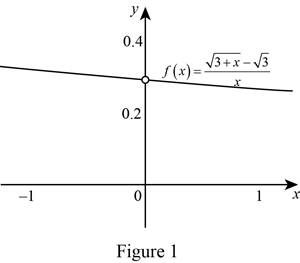
Concept explainers
(a)
To estimate: The value of the function to two decimal places when x approaches zero by using the graph of the function
(a)
Answer to Problem 26E
The estimated value of the function when x approaches zero
Explanation of Solution
Given:
The function
Use the online graphing calculator to draw the graph of the function

From the graph, as
That is,
Thus, the estimated value of
(b)
To estimate: The value of the limit to four decimal places when x close to 0 by using the table of values of
(b)
Answer to Problem 26E
The estimated value of the limit by using the table of values of
Explanation of Solution
Calculation:
Construct the table of values of
| x | |
| −0.001 | |
| −0.000 1 | |
| −0.000 01 | |
| −0.000 001 | |
| 0.000 001 | |
| 0.000 01 | |
| 0.000 1 | |
| 0.001 |
From the table,
That is,
Thus, the limit appears to be approximately equal to
(c)
To find: The exact limit value of the function
(c)
Answer to Problem 26E
The exact limit value of the function is
Explanation of Solution
Given:
The limit of the function as x approaches 0 is
Limit Laws:
Suppose that c is a constant and the limits
Limit law 1:
Limit law 2:
Limit law 3:
Limit law 4:
Limit law 5:
Limit law 7:
Limit law 8:
Limit law 11:
Direct substitution property:
If f is a polynomial or a rational function and a is in the domain of f, then
Difference of square formula:
Fact 1:
If
Let
Note 1:
The direct substitution method is not applicable for the function
Note 2:
The Quotient rule is not applicable for the function
Note 3:
“The limit may be infinite or some finite value when both the numerator and the denominator approach 0.”
Calculation:
By note 3, take the limit x approaches 0 but
Simplify
Take the conjugate of the numerator and multiply and divide by
Apply the formula for the difference of square,
Since the limit x approaches 0 but not equal to 0, cancel the common term
Use fact 1,
Use the limit laws to find the required limit function.
Thus, the exact limit of the function is
Chapter 2 Solutions
Single Variable Calculus: Concepts and Contexts, Enhanced Edition
- = 5 37 A 4 8 0.5 06 9arrow_forwardConsider the following system of equations, Ax=b : x+2y+3z - w = 2 2x4z2w = 3 -x+6y+17z7w = 0 -9x-2y+13z7w = -14 a. Find the solution to the system. Write it as a parametric equation. You can use a computer to do the row reduction. b. What is a geometric description of the solution? Explain how you know. c. Write the solution in vector form? d. What is the solution to the homogeneous system, Ax=0?arrow_forward2. Find a matrix A with the following qualities a. A is 3 x 3. b. The matrix A is not lower triangular and is not upper triangular. c. At least one value in each row is not a 1, 2,-1, -2, or 0 d. A is invertible.arrow_forward
- Find the exact area inside r=2sin(2\theta ) and outside r=\sqrt(3)arrow_forwardA 20 foot ladder rests on level ground; its head (top) is against a vertical wall. The bottom of the ladder begins by being 12 feet from the wall but begins moving away at the rate of 0.1 feet per second. At what rate is the top of the ladder slipping down the wall? You may use a calculator.arrow_forwardExplain the focus and reasons for establishment of 12.4.1(root test) and 12.4.2(ratio test)arrow_forward
- Use 12.4.2 to determine whether the infinite series on the right side of equation 12.6.5, 12.6.6 and 12.6.7 converges for every real number x.arrow_forwarduse Cauchy Mean-Value Theorem to derive Corollary 12.6.2, and then derive 12.6.3arrow_forwardExplain the focus and reasons for establishment of 12.5.4arrow_forward
 Calculus: Early TranscendentalsCalculusISBN:9781285741550Author:James StewartPublisher:Cengage Learning
Calculus: Early TranscendentalsCalculusISBN:9781285741550Author:James StewartPublisher:Cengage Learning Thomas' Calculus (14th Edition)CalculusISBN:9780134438986Author:Joel R. Hass, Christopher E. Heil, Maurice D. WeirPublisher:PEARSON
Thomas' Calculus (14th Edition)CalculusISBN:9780134438986Author:Joel R. Hass, Christopher E. Heil, Maurice D. WeirPublisher:PEARSON Calculus: Early Transcendentals (3rd Edition)CalculusISBN:9780134763644Author:William L. Briggs, Lyle Cochran, Bernard Gillett, Eric SchulzPublisher:PEARSON
Calculus: Early Transcendentals (3rd Edition)CalculusISBN:9780134763644Author:William L. Briggs, Lyle Cochran, Bernard Gillett, Eric SchulzPublisher:PEARSON Calculus: Early TranscendentalsCalculusISBN:9781319050740Author:Jon Rogawski, Colin Adams, Robert FranzosaPublisher:W. H. Freeman
Calculus: Early TranscendentalsCalculusISBN:9781319050740Author:Jon Rogawski, Colin Adams, Robert FranzosaPublisher:W. H. Freeman
 Calculus: Early Transcendental FunctionsCalculusISBN:9781337552516Author:Ron Larson, Bruce H. EdwardsPublisher:Cengage Learning
Calculus: Early Transcendental FunctionsCalculusISBN:9781337552516Author:Ron Larson, Bruce H. EdwardsPublisher:Cengage Learning





